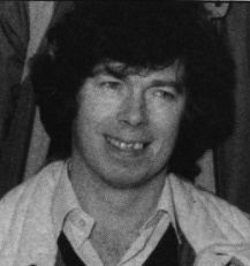
After publishing our reviewers’ ‘All Time Greats’ in Issue 57 we thought it a good idea to ask some of the Spectrum’s best programmers what they thought were the true classics, and which binary maestros they most admired. Asking the questions was fearless PHIL KING, his only conditions: no naming programs or games produced by the programmer’s own regular software house. A rule courteously followed by all... well almost all.
Dominic first came to the attention of Spectrum programmers when he converted Andy Braybrook’s C64 classic Uridium. A Spectrum version of this horizontally-scrolling shoot-’em-up was thought impossible, but Dominic succeeded with a brilliantly playable and very detailed arcade game (90%, Issue 35).
Not content with just one best-selling Spectrum shoot-’em-up, Dominic went on to score another hit with Zynaps (91%, Issue 42). His third game, however, took a completely different approach, being very puzzlish, released on Hewson’s Rack-It label Anarchy earned a very respectable 77% in Issue 43.
Unfortunately for us Spectrum programmers, Dominic has now moved on to 16-bit machines, aiming to repeat there the success he’s had on the Spectrum.
Most admired programmer: John Philips (Impossaball, Nebulus) — ‘his ideas are always original, and he’s so competent technically as to be able to implement them well.’

An ex-schoolteacher, Mike began his career writing games with Space Race for the Commodore PET — achieving record-breaking sales in 1980 of around 300. Fortunately his next game did a lot better, Games Pack One selling 90,000 for the ZX81. After that Mike wrote a variety of games for several machines, while working for the now-defunct Postern. It was for the newly-launched label Beyond label, however, that he made his real breakthrough with a revolutionary ‘landscaping’ technique. The subsequent game, Lords of Midnight, earned an unbeatable ten out of ten in Issue 7’s Adventure Trail. Four years later its classic gameplay keeps it in the CRASH Adventure Chart, along with the sequel Doomdark’s Revenge (10/10, Issue 13). Unfortunately the next revolutionary technique forced the delay of Dark Sceptre until Issue 47 (88%), while the final part of the Midnight trilogy seems almost permanently shelved as Mike develops yet more innovations for his own software label, Maelstrom Games.
Most admired programmer: Jeff Minter (early Llamasoft games and Psychedilia) — ‘he’s gone off at a tangent from mainstream software to explore new avenues, getting out of the ruts created by cloned programs and ideas.’
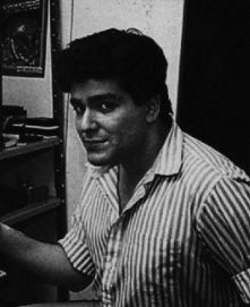
Raf’s first Spectrum success was with Equinox (Issue 30, 87%) which missed being a CRASH Smash by the barest whisker. Over a year later Raf returned with the combative Exolon to earn his first CRASH Smash (90%, Issue 43). Deploying even more fire power was Cybernoid (96%, Issue 51) which is one of the finest shoot-’em-ups ever to appear on the Spectrum. Suitably impressed CRASH invited him to write the diary of his next project Stormlord. Briefly interrupted by the programming of Cybernoid II (88%, Issue 57) the game of the diary should be out for Christmas.
Most admired programmer: Tim Stamper (Ultimate) — ‘Ultimate set new standards in Spectrum software. Theirs were the games which impressed the most — the ‘ultimate’ programming team!’
Along with third Realtime member Graeme Baird, Andy and Ian earned their first CRASH Smash for probably the best Star Wars variant available, Starstrike (93%, Issue 11). A more original sequel — Starstrike II — was an even bigger Smash (96%, Issue 26). Their next big hit was the classic Starglider (95%, Issue 36) which improved on the ST original in playability. Currently Andy is just putting the finishing touches to the Spectrum version of Carrier Command (originally written on the ST by Ian and Graeme).
Most admired programmer: Jon Ritman — ‘he’s very versatile and has tried many different game styles.’
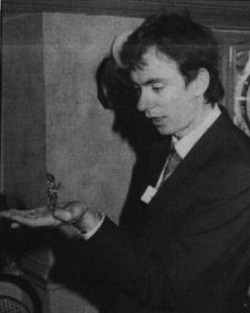
Steve was around in the very early days of Spectrum software with his Hewson trilogy of shoot-’em-ups: 3D Space Wars, 3D Seiddab Attack (79%, Issue 3) and 3D Lunattack (90%, Issue 4). His versatility was subsequently proven by the ‘adventure movies’ The Legend of Avalon (91%, Issue 10) and Dragontorc (92%, Issue 16). He later created the space arcade adventure Astroclone (88%, Issue 22), the brilliant isometric 3-D robot game, Quazatron (94%, Issue 29) and the Gauntlet-inspired Ranarama (90%, Issue 38). More recently Steve has programmed yet another CRASH Smash, Intensity (91%, Issue 57).
‘Each marked a step forward in programming techniques but despite this, all are well-designed games in their own right which are very playable.’
Most admired programmers(s): Raffaele Cecco, John Phillips — ‘they are making more money than me! Seriously, they have used the machine well to create very playable games.’
Dave first achieved fame with his amazing flight simulation, Fighter Pilot (86%, Issue 2). The game was highly acclaimed as one of the most complex, yet enjoyable games of the day and remains one of the most realistic simulations available on the Spectrum. Dave continued his aerial success with the helicopter simulation, Tomahawk (93%, Issue 23). Advertised for ages before it appeared the game actually proved worth the wait, with yet another exceptionally realistic depiction of modern warfare.
Most admired programmer: ‘I can’t think of anyone in particular.’
Mike’s surname may imply gentleness but ironically he is best known for such extremely violent games as that popular beat-’em-up Renegade (89%, Issue 44), the macho military training game; Combat School (with Andrew Deakin) (93%, Issue 48) and finally Target: Renegade (90%, Issue 52). He is aiming to continue this blood-soaked record with the soon-to-be-released Rambo III.
Most admired programmer(s): William Wray (Galaxians), Jonathan Smith, the Ultimate team — ‘they’re all very competent.’
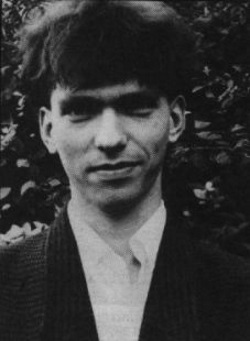
John is best known for his innovative ‘rotating tower’ game, Nebulus (85%, Issue 47). He also programmed the earlier ball-bouncing Impossaball (89%, Issue 37). Unfortunately John, like Dominic, has now defected to the 16-bit machines but it’s unlikely we’ve really seen the last of his ideas since his ST Smash Eliminator is now being converted to the Spectrum.
Most admired programmer(s): the Ultimate team, Steve Turner and C64 programmer Paul Woakes (creator of Mercenary) — ‘you never really know how 3-D games are going to turn out, but he always seems to get it right.’
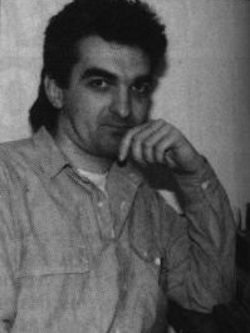
Ace sound and graphics man Sean achieved instant success with his first Spectrum game, the militaristic Smash, 19 Part One — Boot Camp (he did the graphics AND the music — not Rob Hubbard). Sean is currently working on a sound and music system for all formats and his ambition is to create a complete game by himself.
Most admired programmer: John Pickford (formerly of Binary Design) — ‘his programs such as Zub and Amaurote always have nice little touches and excellent presentation.’
The name of Pete Cooke is synonymous with original, complex 3-D space games such as the atmospheric Tau Ceti (94%, Issue 23) and the superb sequel, Academy (92%, Issue 36). Later, he created an innovative 3-D version of Pong, the strangely-titled Room 10 (62%, Issue 35). More recently, Pete programmed the intriguing Smash, Earthlight (90%, Issue 53).
Most admired programmer: Costa Panayi (TLL, Highway Counter) — ‘he has an instantly recognisable style and the content of his games is also distinctive.’
Chris is best known for his work the Major Developments in creating the recent solid 3-D Freescape games Driller (97%, Issue 47) and Dark Side (95%, Issue 54). The Freescape graphics system, which took over 14 months to create, is also being used for Total Eclipse (as seen on last month’s demo cassette.)
Most admired programmer(s): The Ultimate team — ‘they raised the quality of Spectrum games and made other programmers sit up and take notice.
Julian’s futuristic strategy game Rebelstar Raiders achieved cult status, but a revised version, released on the Firebird Silver (now Silverbird) earned a well-deserved CRASH Smash — Rebel Star (93%, Issue 31). His latest release — Laser Squad — took many months of hard work and is reviewed in this issue’s Frontline section. The game is available from Target Games which is Julian’s own company, for which he is currently working on expansion modules.
Most admired programmer(s): R T Smith (Vulcan, Arnhem) — ‘all his games are very well designed and also well programmed.’
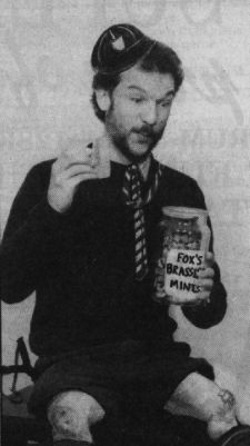
Well, what can be said about the mysterious Mel? He was around in the pioneering days of Spectrum software as co-founder (with Christian Penfold) of Automata, and conceived many innovative games such as Deus Ex Machina (complete with synchronised soundtrack! — unrated in Issue 10), My Name is Uncle Groucho, You Win a Fat Cigar and PiMania which achieved a cult following. After leaving Automata (on April Fool’s Day!) in 1985, he instigated equally innovative projects at CRL, including the intriguing ID in which an alien lifeform, with a realistic personality, took up residence in the computer. Now, of course, Mel is a freelance writer — his Monitor articles are currently running in alternate issues of CRASH.
‘They are all just brilliant!’
Other people’s games: ‘I hate them all!’
Most admired programmer(s): Augusta Ada Byron — ‘she wrote the first ever book about computer programs in 1843, at the age of 28. She died age 36 from consumption, but she was dead right about computers!’ (?)
David has recently completed the soccer management game, Professional Football (reviewed in this issue) for CRL. He’s currently working on with the Binary Design team on the Spectrum version of the oriental beat-’em-up coin-op, Double Dragon, for Melbourne House.
Most admired programmer: John Pickford — ‘my predecessor at Binary Design : he wrote the technically excellent Amaurote and the very playable Zub.’
Another ‘veteran’ Spectrum programmer, Christian produced many early games including Hunchback (66%, Issue 2), the perenially popular Daley Thompson’s Decathlon (82%, Issue 10), Robot Messiah (for his own label, Alphabatim — 72%, Issue 24) and more recently for Destiny Software, The Bobby Yazz Show (85%, Issue 57).
‘They’ve all got plenty of game content.’
Most admired programmer: Mike Singleton — ‘he lives just down the road!’
Best known for the classic football games Match Day (86%, Issue 13) and Match Day II (91%, Issue 48) Jon has also created (with graphics man Bernie Drummond) some great isometric arcade adventures like Batman and Head Over Heels. He’s now working on a football arcade game for Rare (formerly Ultimate).
Most admired programmer: Chris Stamper — ‘over the years Ultimate have produced the most amazing games.’
Mike’s first Spectrum game was the 3-D shoot-’em-up for Insight, Vectron (92%, Issue 24). He also programmed the Spectrum version of The Sentinel (97%, Issue 40), and the excellent coin-op conversions Bubble Bobble (90%, Issue 45) and Bionic Commando (92%, Issue 53). Mike is currently working on the Spectrum versions of the new GO!/Capcom racing game, LED Storm.
Most admired programmer: Jonathan Smith — ‘he’s so competent technically.’
Donald is known for his work for Tiertex (which he co-founded with John Prince just over a year ago) on coin-op conversions such as Street Fighter (69%, Issue 53) and 720°. Tiertex also programmed the original Rolling Thunder (47%, Issue 50). Donald is now working with the rest of the Tiertex team on Thunder Blade.
Most admired programmer: Jon Ritman — ‘whether it’s football games or isometric adventure games, all his stuff is very well thought out and technically competent.’
Andrew has previously worked on the Spectrum version of
Most admired programmer: Jonathan Smith (currently working on the second Batman game — demoed on the next issue of CRASH) — ‘he’s consistently produced playable games with excellent scrolling.’
Well, what can be said about Ultimate: Play The Game that hasn’t been said already. In their day, which stretched from Jetpac (1983) to Pentagram (1986), they were undoubtedly the finest software house around. Their refusal to give interviews, the superb packaging and their brilliant games gave a mystique which has yet to be replicated. Moreover, virtually all their games were excellent, some established game types of today find their roots in one or other of the Ultimate games. Atic Atac for example was probably the first arcade-adventure, while the influence of Knight Lore‘s isometric Filmation 3-D remains powerful even today. Ultimate always emphasised attention to detail and playability making Ultimate: The Collected Works an essential purchase more than three years after the last of the games were written. Games such as Pssst, Sabre Wulf, Underwurlde and Gunfright still captivate. All the more reason to mourn, then, the passing of this great software house into Spectrum history. Today the Stamper brothers head Rare, a company formed two years ago to work on Nintendo games and original coin-ops. Here’s what the programmers’ programmers remember when they look back into the history of the Spectrum.
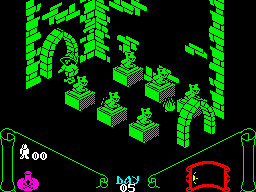
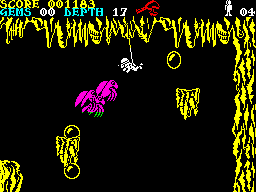
Most admired programmer: Jon Ritman (now working for Rare!) — ‘he’s been around a long time (no offence meant!) and has produced some of the most playable games on the Spectrum.’
On being voted the best programmers, plus having their game Knight Lore voted best game: ‘We’re absolutely delighted; we are a group of individuals who just love games and the software industry. What started as a hobby is now our job and to get paid for what we enjoy doing is great. Even now we still love to play games and take great delight in seeing our products develop.’